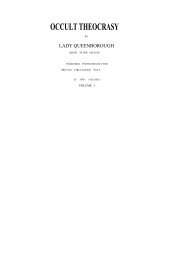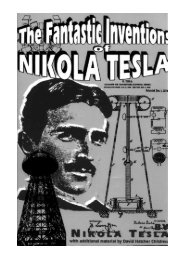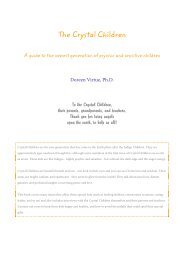the fantastic inventions of nikola tesla - Exopolitics Hong Kong
the fantastic inventions of nikola tesla - Exopolitics Hong Kong
the fantastic inventions of nikola tesla - Exopolitics Hong Kong
Create successful ePaper yourself
Turn your PDF publications into a flip-book with our unique Google optimized e-Paper software.
currents <strong>of</strong> very high frequency <strong>the</strong> positive and negative impulses are not equal, but that one always preponderates<br />
over <strong>the</strong> o<strong>the</strong>r.<br />
Of course, this rotation in one direction may be due to <strong>the</strong> action <strong>of</strong> two elements <strong>of</strong> <strong>the</strong> same current upon each<br />
o<strong>the</strong>r, or to <strong>the</strong> action <strong>of</strong> <strong>the</strong> field produced by one <strong>of</strong> <strong>the</strong> elements upon <strong>the</strong> o<strong>the</strong>r, as in a series motor, without necessarily<br />
one impulse being stronger than <strong>the</strong> o<strong>the</strong>r. The fact that <strong>the</strong> brush turns, as far as I could observe, in any<br />
position, would speak for this view. In such case it would turn at any point <strong>of</strong> <strong>the</strong> earth's surface. But, on <strong>the</strong> o<strong>the</strong>r<br />
hand, it is <strong>the</strong>n hard to explain why a permanent magnet should reverse <strong>the</strong> rotation, and one must assume <strong>the</strong> preponderance<br />
<strong>of</strong> impulses <strong>of</strong> one kind.<br />
As to <strong>the</strong> causes <strong>of</strong> <strong>the</strong> formation <strong>of</strong> <strong>the</strong> brush or stream I think it is due to <strong>the</strong> electrostatic action <strong>of</strong> <strong>the</strong> globe and<br />
<strong>the</strong> dissymmetry <strong>of</strong> <strong>the</strong> parts. If <strong>the</strong> small bulb s and <strong>the</strong> globe L were perfect concentric spheres, and <strong>the</strong> glass<br />
throughout <strong>of</strong> <strong>the</strong> same thickness and quality, I think <strong>the</strong> brush would not form, as <strong>the</strong> tendency to pass would be<br />
equal on all sides. That <strong>the</strong> formation <strong>of</strong> <strong>the</strong> stream is due to an irregularity is apparent from <strong>the</strong> fact that it has <strong>the</strong><br />
tendency to remain in one position, and rotation occurs most generally only when it is brought out <strong>of</strong> this position<br />
by electrostatic or magnetic influence. When in an extremely sensitive state it rests in one position, most curious<br />
experiments may be performed with it. For instance, <strong>the</strong> experimenter may, by selecting a proper position,<br />
approach <strong>the</strong> hand at a certain considerable distance to <strong>the</strong> bulb, and he may cause <strong>the</strong> brush to pass <strong>of</strong>f by merely<br />
stiffening <strong>the</strong> muscles <strong>of</strong> <strong>the</strong> arm. When it begins to rotate slowly, and <strong>the</strong> hands are held at a proper distance, it is<br />
impossible to make even <strong>the</strong> slightest motion without producing a visible effect upon <strong>the</strong> brush. A metal plate<br />
connected to <strong>the</strong> o<strong>the</strong>r terminal <strong>of</strong> <strong>the</strong> coil affects it at a great distance, slowing down <strong>the</strong> rotation <strong>of</strong>ten to one turn<br />
a second.<br />
I am firmly convinced that such a brush, when we learn how to produce it properly, will prove a valuable aid in <strong>the</strong><br />
investigation <strong>of</strong> <strong>the</strong> nature <strong>of</strong> <strong>the</strong> forces acting in an electrostatic or magnetic field. If <strong>the</strong>re is any motion which is<br />
measurable going on in <strong>the</strong> space, such a brush ought to reveal it. It is, so to speak, a beam <strong>of</strong> light, frictionless,<br />
devoid <strong>of</strong> inertia.<br />
I think that it may find practical applications in telegraphy. With such a brush it would be possible to send<br />
dispatches across <strong>the</strong> Atlantic, for instance, with any speed, since its sensitiveness may be so great that <strong>the</strong> slightest<br />
changes will affect it. If it were possible to make <strong>the</strong> stream more intense and very narrow, its deflections could be<br />
easily photographed.<br />
I have been interested to find whe<strong>the</strong>r <strong>the</strong>re is a rotation <strong>of</strong> <strong>the</strong> stream itself, or whe<strong>the</strong>r <strong>the</strong>re is simply a stress<br />
traveling around in <strong>the</strong> bulb. For this purpose I mounted a light mica fan so that its vanes were in <strong>the</strong> path <strong>of</strong> <strong>the</strong><br />
brush. If <strong>the</strong> stream itself was rotating <strong>the</strong> fan would be spun around. I could produce no distinct rotation <strong>of</strong> <strong>the</strong> fan,<br />
although I tried <strong>the</strong> experiment repeatedly; but as <strong>the</strong> fan exerted a noticeable influence on <strong>the</strong> stream, and <strong>the</strong><br />
apparent rotation <strong>of</strong> <strong>the</strong> latter was, in this case, never quite satisfactory, <strong>the</strong> experiment did not appear to be<br />
conclusive.<br />
I have been unable to produce <strong>the</strong> phenomenon with <strong>the</strong> disruptive discharge coil, although every o<strong>the</strong>r <strong>of</strong> <strong>the</strong>se<br />
phenomena can be well produced by it—many, in fact, much better than with coils operated from an alternator. It<br />
may be possible to produce <strong>the</strong> brush by impulses <strong>of</strong> one direction, or even by a steady potential, in which case it<br />
would be still more sensitive to magnetic influence.<br />
In operating an induction coil with rapidly alternating currents, we realize with astonishment, for <strong>the</strong> first time, <strong>the</strong><br />
great importance <strong>of</strong> <strong>the</strong> relation <strong>of</strong> capacity, self-induction and frequency as regards <strong>the</strong> general result. The effects<br />
<strong>of</strong> capacity are <strong>the</strong>' most striking, for in <strong>the</strong>se experiments, since <strong>the</strong> self-induction and frequency both are high, <strong>the</strong><br />
critical capacity is very small, and need be but slightly varied to produce a very considerable change. The<br />
experimenter may bring his body in contact with <strong>the</strong> terminals <strong>of</strong> <strong>the</strong> secondary <strong>of</strong> <strong>the</strong> coil, or attach to one or both<br />
terminals insulated bodies <strong>of</strong> very small bulk, such as bulbs, and he may produce a considerable rise or fall <strong>of</strong><br />
potential, and greatly affect <strong>the</strong> flow <strong>of</strong> <strong>the</strong> current through <strong>the</strong> primary. In <strong>the</strong> experiment before shown, in which a<br />
brush appears at a wire attached to one terminal, and <strong>the</strong> wire is vibrated when <strong>the</strong> experimenter brings his<br />
insulated body in contact with <strong>the</strong> o<strong>the</strong>r terminal <strong>of</strong> <strong>the</strong> coil, <strong>the</strong> sudden rise <strong>of</strong> potential was made evident.<br />
I may show you <strong>the</strong> behavior <strong>of</strong> <strong>the</strong> coil in ano<strong>the</strong>r manner which possesses a feature <strong>of</strong> some interest. I have here a<br />
little light fan <strong>of</strong> aluminium sheet, fastened to a needle and arranged to rotate freely in a metal piece screwed to one<br />
<strong>of</strong> <strong>the</strong> terminals <strong>of</strong> <strong>the</strong> coil. When <strong>the</strong> coil is set to work, <strong>the</strong> molecules <strong>of</strong> <strong>the</strong> air are rhythmically attracted and<br />
repelled. As <strong>the</strong> force with which <strong>the</strong>y are repelled is greater than that with which <strong>the</strong>y are attracted, it results that<br />
<strong>the</strong>re is a repulsion exerted on <strong>the</strong> surfaces <strong>of</strong> <strong>the</strong> fan. If <strong>the</strong> fan were made simply <strong>of</strong> a metal sheet, <strong>the</strong> repulsion<br />
would be equal on <strong>the</strong> opposite sides, and would produce no effect. But if one <strong>of</strong> <strong>the</strong> opposing surfaces is screened,









